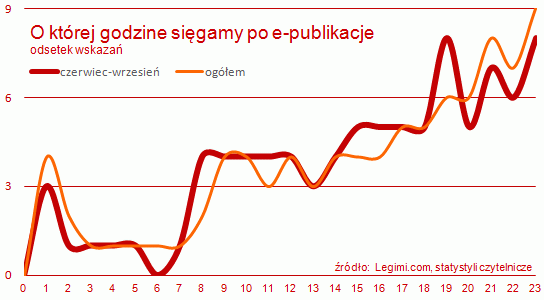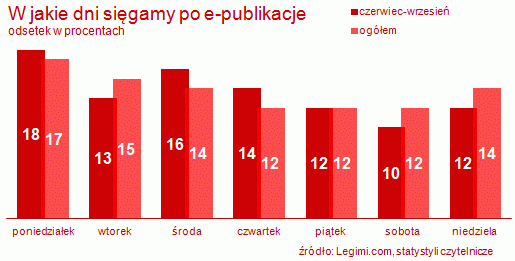
Summer shows a more evenly spread tendency to read digital publications throughout the day. However, evenings clearly dominate, especially late evenings, with a noticeably higher percentage of e-readers at the end of the day.
For Android devices, peak reading times during summer were at 2 p.m. (14% of respondents) and 9 p.m. (10%); iPad users read most around 8 a.m. and 4 p.m. (13% each), while iPhone e-book readers usually read at 9 p.m. (28%) and 1 p.m. (18%) - according to the study authors from Legimi. This indicates that smartphone users (both Android and iPhone) prefer reading during lunch and late in the evening.
Interestingly, according to analyses from the digital publications platform, e-reader owners are less predictable, reading at different times of day and night. 3% of respondents reported using their reader between 1 and 2 a.m., 5% at 9 a.m., 8% at 6 p.m., and 9% at 10 p.m. When combining results across all devices, peak reading times were in the late afternoon and evening (6 p.m. and 11 p.m. - 9% each).

One might think weekends are when we read the most. However, this isn’t true, as e-book and e-newspaper readers report otherwise. Summer weekends saw noticeably less reading than weekdays, with Monday, Tuesday, and Wednesday standing out. - This may be because popular weeklies, also available in digital editions, are released on those days - suggest the study authors.
Outside of the vacation period, Android phone or smartphone users typically read at the beginning of the week (32% on Monday, 23% on Tuesday, and only 2% on Sunday).
COMMERCIAL BREAK
New articles in section Media industry
Journalism in the age of AI. Why people prefer humans over machines
Krzysztof Fiedorek
Only 12% of people accept news created solely by AI, while 62% prefer those written by humans. At the same time, only 19% notice labels indicating the use of artificial intelligence, while younger audiences ask AI to explain the content to them. These are the findings of the Reuters Institute report on artificial intelligence in media.
Why do we believe fakes? Science reveals the psychology of virals
KFi
Why do emotions grab more attention than evidence, and why can a fake authority overshadow scientific data? Researchers from Warsaw University of Technology, Jagiellonian University, and SWPS University in Poland sought the answers. Here are their findings.
Investigative journalism in Europe. Newsrooms face pressure
KFi, Newseria
Media and political representatives point to the difficult situation of investigative journalism in Europe. Newsrooms are reluctant to invest in this segment due to high costs and the large amount of time and effort required. Most of all, however, they fear legal proceedings.
See articles on a similar topic:
Future of Public Media. Who Will Be Data Ethicists and VR Designers?
KFi
How does the future of work in media look? Here are professions that do not yet exist but will soon become essential. The report "Future Jobs at PSM: Competencies and Professions for the Media of Tomorrow," prepared by the European Broadcasting Union (EBU) and Rai Ufficio Studi, outlines key changes awaiting the public media sector in the coming years.
Decline in Trust in Media. Analysis of the Reuters Digital News Report 2024
Krzysztof Fiedorek
The “Digital News Report 2024” by the Reuters Institute for the Study of Journalism highlights alarming trends concerning the declining interest in news and decreasing trust in media. These changes are not temporary but have become a long-term trend.
Artificial Intelligence in the Media. Reuters Digital News Report 2024
Krzysztof Fiedorek
AI has gained prominence in recent years, and its application in producing, distributing, and presenting news content continues to grow. However, this development is met with mixed feelings by audiences, which has significant consequences for media trust and its future.
Work in the media. We have more recruitment offers at Reporterzy.info [LINK]
AUTOPROMOCJA Reporterzy.info
Thanks to cooperation with the recruitment website Talent.com, the database of recruitment advertisements published in Reporterzy.info has been significantly enriched. We invite you to browse current job offers and internships in the media and advertising industry from the largest Polish cities.






























